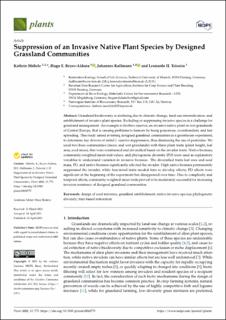Suppression of an invasive native plant species by designed grassland communities
| dc.contributor.author | Möhrle, Kathrin | |
| dc.contributor.author | Reyes-Aldana, Hugo E. | |
| dc.contributor.author | Kollmann, Johannes | |
| dc.contributor.author | Teixeira, Leonardo H. | |
| dc.date.accessioned | 2022-02-21T09:53:50Z | |
| dc.date.available | 2022-02-21T09:53:50Z | |
| dc.date.created | 2022-02-03T18:48:31Z | |
| dc.date.issued | 2021-04-15 | |
| dc.identifier.citation | Plants. 2021, 10 (4), . | en_US |
| dc.identifier.issn | 2223-7747 | |
| dc.identifier.uri | https://hdl.handle.net/11250/2980417 | |
| dc.description.abstract | Grassland biodiversity is declining due to climatic change, land-use intensification, and establishment of invasive plant species. Excluding or suppressing invasive species is a challenge for grassland management. An example is Jacobaea aquatica, an invasive native plant in wet grasslands of Central Europe, that is causing problems to farmers by being poisonous, overabundant, and fast spreading. This study aimed at testing designed grassland communities in a greenhouse experiment, to determine key drivers of initial J. aquatica suppression, thus dismissing the use of pesticides. We used two base communities (mesic and wet grasslands) with three plant traits (plant height, leaf area, seed mass), that were constrained and diversified based on the invader traits. Native biomass, community-weighted mean trait values, and phylogenetic diversity (PD) were used as explanatory variables to understand variation in invasive biomass. The diversified traits leaf area and seed mass, PD, and native biomass significantly affected the invader. High native biomass permanently suppressed the invader, while functional traits needed time to develop effects; PD effects were significant at the beginning of the experiment but disappeared over time. Due to complexity and temporal effects, community weighted mean traits proved to be moderately successful for increasing invasion resistance of designed grassland communities. | en_US |
| dc.language.iso | eng | en_US |
| dc.publisher | MDPI, Basel, Switzerland | en_US |
| dc.rights | Navngivelse 4.0 Internasjonal | * |
| dc.rights.uri | http://creativecommons.org/licenses/by/4.0/deed.no | * |
| dc.title | Suppression of an invasive native plant species by designed grassland communities | en_US |
| dc.type | Peer reviewed | en_US |
| dc.type | Journal article | en_US |
| dc.description.version | publishedVersion | en_US |
| dc.rights.holder | © 2021 by the authors | en_US |
| dc.source.pagenumber | 14 | en_US |
| dc.source.volume | 10 | en_US |
| dc.source.journal | Plants | en_US |
| dc.source.issue | 4 | en_US |
| dc.identifier.doi | 10.3390/plants10040775 | |
| dc.identifier.cristin | 1997588 | |
| dc.source.articlenumber | 775 | en_US |
| cristin.ispublished | true | |
| cristin.fulltext | original | |
| cristin.qualitycode | 1 |
Tilhørende fil(er)
Denne innførselen finnes i følgende samling(er)
-
Divisjon for miljø og naturressurser [756]
Publikasjoner knyttet til ansatte ved Divisjon for miljø og naturressurser -
Publikasjoner fra CRIStin - NIBIO [4576]
-
Vitenskapelige artikler [1416]

